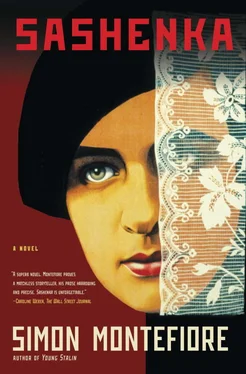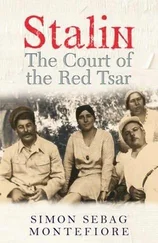She noted the list was addressed to Stalin and the Politburo and signed in a tiny, neat green ink by L. P. Beria, Narkom NKVD .
Shcheglov’s finger traveled to the scrawls around the typed names:
Agreed. Molotov
Crush these traitors like snakes. I vote for the Vishka! Kaganovich
Shoot these whores and scoundrels like dogs. Voroshilov
And most decisively:
Shoot them all.
J. St.
“So they were sentenced,” she said, “but were they all…?”
“Scene two.” Shcheglov slid the document across the desk with a flourish, turned back to the shelf, hunted around for a few moments and then presented a scuffed memorandum, bearing in its careless scrawl and clumsy blotting the grinding boredom, stained desks, greasy fingers and the rough routine of prisons.
To Comrade Commandant of Special Object 110, Golechev
21 January 1940
Transfer to Major V. S. Blokhin, Head of Command Operations, the below-mentioned prisoners condemned to be shot…
The 123 names on the list were typed below. Sashenka and Vanya were near the top. A bunch of more than a hundred blotched, crumpled chits—pro-forma memoranda with the names and dates filled in—was held together by a thick red string pushed through a hole in the sheaf.
Her hands shaking, Katinka found Vanya Palitsyn’s chit.
On the orders of Comrade Kobylov, Deputy Narkom NKVD, the undersigned on 21 January 1940 at 4:41 a.m. carried out the sentence of shooting on …and here the semiliterate scribble of a half-drunk executioner added the name Palitsyn, Ivan . The man who carried out the sentence was V. S. Blokhin . Katinka had heard of him from Maxy: he usually wore a butcher’s leather apron and cap to shield his beloved NKVD uniform from the spatter of blood.
Katinka felt herself in the presence of evil and nothingness. She was not crying, she was too overwhelmed for that. Instead she felt dizzy and faint.
The other chits were the same. She could only think that every scrap, so sloppily filled in, was the end of a life and a family. She could barely bring herself to look at Sashenka’s—but then she started to turn the pages too fast, almost tearing them.
“I can’t find her,” she said, her voice shaking.
Shcheglov looked at his watch. “We haven’t got long before my colleague returns. Now we go back over six months to how the case began. Take a look at this. Scene three.”
He placed a yellowing piece of paper before her, headed in black type— OFFICE OF J. V. STALIN. Its entire surface was covered in squiggles and shading in thick green and red crayon, doodles of wolves and apparently random words. But Stalin’s secretary had annotated the exact date and time: 7 May 1939. Sent to archives 11:42 p.m . That was the evening when Beria had shown Stalin the transcript of Sashenka and Benya in bed together at the Metropole.
Katinka looked into the bottle-thick, greasy lenses of Shcheglov’s spectacles, which reflected her own anxious eyes, then down at the papers before her. Slowly, she started to piece together the drama of the night that had doomed Sashenka and her whole family. She knew how Stalin had read the bugging transcript and hated it, calling Sashenka morally corrupt…like a streetwalker . She got her notebook out of her bag and glanced back at the order of Stalin’s visitors that night:
10:00 p.m. L. P. Beria.
Leaves 10:30 p.m.
10:30 p.m. H. A. Satinov.
Leaves 10:45 p.m.
10:40 p.m. L. P. Beria.
Leaves 10:52 p.m.
By the time Beria left Stalin’s office at 10:30 p.m., Satinov was waiting in the anteroom. Stalin called in Satinov and asked him about Sashenka’s affair.
Katinka perused the new page of Stalin’s squiggles and, with a rising horror, she started to understand.
Questions for Comrade Satinov: Sashenka in St. Petersburg was in the middle of the page, surrounded by circles, squares and a finely drawn fox’s face, shaded in red and entitled Comrade Snowfox . Satinov must have answered these questions coolly because Stalin scrawled down his answer: Old friends, devoted Bolsheviks .
Then Stalin called in Beria again and they intensified their cross-examination of Satinov. The next words were scarcely legible.
“I can’t quite read this,” she said.
The archivist followed the words with his finger and read out:
Snowfox in St. Petersburg reliable/unreliable?
L. P. Beria: Molotov and Mendel in St. Petersburg?
Katinka realized that these were all questions to Satinov. She started to imagine his struggle for survival during those five minutes. What could he say? He must have been pale, sweating, his mind spinning. He had a sweet wife and a new baby, but he was a devoted Communist and an ambitious man. His answers during those five minutes would either save his life and make his career, or destroy his own life and that of his wife and baby.
When Stalin asked about Sashenka’s “reliability” in Petersburg, a name must have come to Satinov’s mind: Captain Sagan, whom he knew of only from his dealings with Mendel in late 1916.
Did Stalin already know about Sashenka’s mission to turn Sagan, and that it had been ordered by the Petersburg Committee? If he talked about it now, and no one knew of it, it could taint Sashenka, although this was unlikely since Sagan had been dead for twenty-two years.
But what if Molotov or Mendel, the only others apart from Sashenka who knew about the Sagan operation, had already discussed it with Stalin? Satinov would then be accused of hiding it from the Party, from Stalin himself. That was unthinkable. That would mean death.
Katinka stared down at the crayoned hieroglyphics that revealed this feverish game of Russian roulette that would still decree the destinies of people fifty years later.
So what did Satinov do? Did he panic and say more than he meant? Or did he calculate and act in cold blood?
“We’ll probably never know.” She found she was talking aloud.
“But we do know he said this …,” replied Shcheglov, his finger showing her the next words written by Stalin on this crowded piece of paper: Hercules S: Cpt Sagan. Petersburg. SAGAN
Katinka went cold. So Satinov had told Stalin and Beria about Sashenka and Captain Sagan of the Okhrana. She felt pity for Satinov, and then anger, and then pity again. He might have answered differently if he had known that Captain Sagan was alive—and in one of Beria’s camps, his name meticulously filed in the NKVD roster of prisoners. Within hours, Sagan was on his way to Moscow and Kobylov was beating him into testifying against Sashenka.
“If Satinov had brazened it out,” she whispered, “they might all have survived.”
“Or he might have faced the Vishka too,” Shcheglov pointed out. “Have you seen enough?” He started to gather up the papers and put them away in his orderly files where they would rest, perhaps forever.
“So Satinov doomed his best friends,” Katinka mused, “but then risked everything to save their children. Does that redeem him?”
Shcheglov gestured toward the elevator, in a hurry to get her out of his office, but she gripped his arms. “Hang on, there’s one thing missing. Stalin created a commission to investigate Sashenka’s execution. Where is its report?”
“There was a number for the file,” said Shcheglov, guiding her toward the elevator. “But the file’s not here. Sorry, but only God knows everything.” He pressed the button to call the elevator.
“Thank you for showing me this,” she said, kissing him as she left. “You’ve been very kind. I can’t tell you what this means to me.”
Читать дальше












